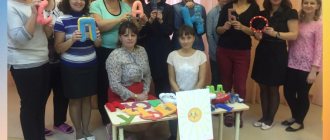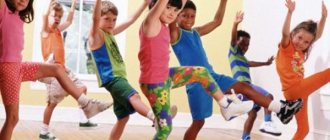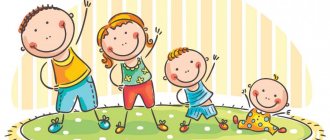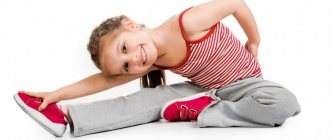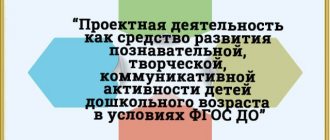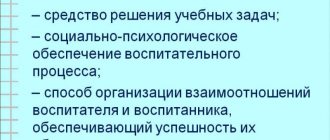Self-analysis of morning exercises in the middle group of preschool educational institutions
Self-analysis of morning exercises
"Journey to the Winter Forest"
(middle group)
This complex of morning exercises is current in the long-term planning for the month. The complex is interconnected with other complexes on the theme: “Winter”, “Winter fun” and is based on the children’s experience in performing motor skills. This complex contributes to the development of children’s physical qualities; strengthening motor skills.
When preparing for morning exercises, the age characteristics of children in the middle group were taken into account: unstable excitability of children, high mobility, emotional instability.
To carry out organized activities, the following was provided:
– the day before, the children were warned about the presence of guests;
– wet cleaning and ventilation of the room for morning exercises was carried out;
– the outline of the morning exercises was learned and prepared by the teacher (I did not resort to the help of the outline during the implementation);
– the exercises were performed to the sound of a tambourine (if required);
– the duration of morning exercises was 6-8 minutes.
So, the goal of morning exercises is to strengthen the motor skills of children, therefore, based on the goal, the tasks of morning exercises were as follows:
1) exercise children in walking and running in various ways;
2) develop the ability to act on a signal from the teacher;
3) teach children to perform exercises in accordance with the spoken words of the text, because the complex of morning exercises was united by a single plot;
4) make children want to participate in morning exercises.
The form of organization of children is frontal (all together). The structure of morning exercises consisted of 3 parts.
In the introductory part, where the children practiced walking in various ways and acted on the teacher’s signal. While walking, the children’s posture, the distance between children, and the quality of exercises were monitored. The introductory part ended with formation in a circle (at the teacher’s signal, when they entered the forest clearing)
In the second part - general developmental exercises - 5 general developmental exercises were used. Each exercise was repeated 5-6 times. This dosage corresponds to the age of children of the middle group. General developmental exercises were also united by a common theme, where proper breathing, IP, synchronicity and quality of exercises were monitored. In this complex, the exercises were given in the following sequence.
– for the muscles of the shoulder girdle and arms;
– for the muscles of the lumbar region;
- for legs.
This sequence is provided for by the methodology for conducting morning exercises, the “Childhood” program, and in accordance with the age of the children.
To reduce the general arousal of the body, the final part included one type of walking, running at a moderate pace, and regular walking one after another with an exercise to restore breathing.
After completing these exercises, the children again found themselves in a fairy-tale forest clearing, where a surprise moment awaited them - a low-mobility game with the word “Winter-winter”, where the main character is the Snowman (Teacher).
This game was not previously familiar to children and was played for the first time. The hero's movements were constructed in accordance with the text. The snowman and the children performed the movements simultaneously, repeating the words of the text. The game was played 2-3 times. The snowman used imitative movements. Imitative exercises interested the children, helped them cope better with the task, and their playful form made the children want to repeat these movements. The teacher’s speech was clear, expressive, and emotionally charged.
Throughout the morning exercises, the teacher performed all the exercises with the children from beginning to end. Methods such as: explanations and instructions were used during the exercises. I also used praise and an example from another child.
I was satisfied with the morning exercises; the children did it with desire and pleasure. By playing, I managed to evoke an emotional response to “Journey into the Winter Forest.” I consider the previously set goals and objectives achieved.
Teacher training. Teacher's assessment of morning exercises
Morning exercises with children of the sixth year of life (group “Fantasers”) Read more: I am a hunchbacked beast, but the children like me
3.6 Teacher training. Teacher's assessment of morning exercises.
In order to achieve an effective effect of morning exercises on the child’s body, you need to draw up a plan, determine the sequence of exercises, think through and correctly write down methodological instructions. At the same time, the teacher must remember the ways of organizing children, the dosage and pace of exercises, methods of conducting them, the nature of the demonstration, explanations and instructions, as well as the methods of implementing moral, mental, aesthetic and labor education. He makes sure that children know how to perform all the exercises correctly and are familiar with the images included in the morning exercises complex.
It is very important to create hygienic conditions in the room and on the playground (site), take care of appropriate clothing and shoes for children, and prepare physical education aids.
To give a correct assessment of your actions during morning exercises, you need to systematically monitor the quality of the exercises, the well-being of the children, and their behavior. Analyzing these behaviors, the teacher notes the positive aspects, identifies shortcomings and draws appropriate conclusions, and then makes changes to the complex of morning exercises and clarifies the methodology for its implementation. (See Appendix 1)
4 The use of musical accompaniment during morning exercises
Performing exercises to music helps to create correct ideas about the nature of movements, their tempo and rhythm. Children perceive the shades of a piece of music well and change the nature of their movements in accordance with the music. When the sound of cheerful music or marching sounds, they pull themselves up, walk briskly and cheerfully, raising their heads and straightening their backs. Walking becomes attractive and emotionally charged for them. Smooth, quiet music encourages you to walk calmly, with long strides. Fast, loud music encourages children to run, jump, a sudden end of music or an expressive chord serves as signals to stop or change movement, etc.
Musical accompaniment increases the expressiveness of motor actions, helps coordinate the movements of the team, increases the amplitude and plasticity of movements. Music disciplines students, increases their attention and performance. Positive emotions that arise during exercise to music enhance their physiological effect. The sound of music is most desirable at those moments in class when all the children are performing the same actions together at the same tempo and rhythm.
First of all, such basic movements as walking, running, jumping in place and moving forward begin to the music. Under the influence of music they become clearer, rhythmic, and coordinated. With the help of music, you can change the pace, types of walking or running, alternate walking with running, change direction, etc. Simple exercises in throwing and catching a ball, passing a ball in a circle, etc. are also performed to the music.
Some basic movements, such as balance exercises, throwing away and at a target, long and high jumps, climbing, should not be accompanied by music: they require an individual tempo of execution, great attention and concentration. In such exercises, music does not help improve the quality of movements, but distracts attention from movements and limits them.
Carrying out basic movements to music is possible in all age groups of kindergarten.
General developmental exercises with musical accompaniment are carried out mainly in older age groups. Musical accompaniment of general developmental exercises is advisable if they are quite simple, well mastered by children and are performed by them freely and naturally. The child finds it difficult to act in accordance with the music. If he has poor movement skills. Therefore, any movement must first be learned with children without musical accompaniment. Of the general developmental exercises, the most convenient ones to perform while listening to music are arm movements, squats, bends, and turns.
A number of exercises from a sitting position, lying on the back, on the stomach, the successful implementation of which depends on significant strength efforts and the individual capabilities of each child (bending, raising and lowering the legs, etc.), are most often performed without musical accompaniment and even without counting.
Some outdoor games with walking, running (“Bear and Children”, “Horses”), jumping (“Goats and the Wolf”, “Birds and the Car”, etc.) are sometimes played to music.
Games with singing, round dance games (“Kalina”, “Teremok”, “Zainka”), dance elements and dance steps (polka step, gallop, side steps with squats, jumps with forward movement, various types of circles, half-squat, etc.) are also widely used. rope, etc.) more often than other movements need musical accompaniment.
During morning exercises, the sound of music organizes the entire set of exercises; its selection depends on their content. In a physical education lesson, an introductory part, general developmental exercises, rhythmic dance movements and some games in the main part of the lesson, a final walk, and a song are performed to music.
To choose the right musical accompaniment, you need to have a good idea of each exercise, understand its meaning and purpose. The selection of music is carried out by the music worker together with the teacher. This takes into account the nature of the movements and the age of the children. In the middle group, musical accompaniment should have a particularly pronounced size of musical phrases, be carried out at a slower pace and with a sharper change of melodies than in the older group. When choosing musical works and musical-rhythmic movements, continuity between musical and physical education classes is ensured. It is necessary to constantly ensure that the music in form, content, and tempo of performance is convenient for performing the exercise. This type of music contributes to the formation of correct movement skills and their improvement. The melody of a musical work must not be allowed to be distorted in order to make it more convenient to accompany a particular movement. Preserving the musical integrity of a work is a prerequisite when using music in classes to develop children’s movements.
Music helps to better organize classes and increase their density. Freeing the teacher from regulating the tempo and rhythm of exercises and from counting, it allows him to concentrate on the pedagogical process, explanations, individual instructions and assistance, and correcting mistakes as the exercises progress. Musical accompaniment makes it possible to achieve not only high clarity and accuracy, but also plasticity and expressiveness of movements. This is largely facilitated by children’s motor improvisations on various topics in accordance with the rhythm and nature of the music. [6]
Conclusion
Morning exercises in a preschool institution are an important component of the motor regime. It provides a good mood and increases vitality. Morning exercises involve the child’s entire body in an active state, deepen breathing, increase blood circulation, promote metabolism, raise emotional tone, cultivate attention, determination, evoke positive emotions and joyful sensations, increase the vital activity of the body, and provide a high healing effect. Children who systematically engage in morning exercises lose their drowsiness, feel more alert, and improve their performance.
Daily morning exercises at a certain time in a hygienic environment, properly selected sets of physical exercises, disinhibit the nervous system of children after sleep, activate the activity of all internal organs and systems, increase physiological metabolic processes, increase the excitability of the cerebral cortex, as well as the reactivity of the entire central nervous system . The flow of impulses going to the brain from all receptors - visual, auditory, musculoskeletal, skin - increases the vital activity of the body as a whole.
In addition to its health benefits, morning exercises also have great educational value. Its systematic implementation instills in children the habit of doing physical exercise every day, teaches them to start their work day in an organized manner, act in a coordinated manner in a team, be purposeful, attentive, self-controlled, and also evokes positive emotions and a joyful feeling. In addition, daily performance of certain sets of physical exercises helps improve motor abilities in children, develops physical qualities (strength, agility, flexibility), improves the functioning of coordination mechanisms, and contributes to the acquisition of knowledge in the field of physical education.
Thus, morning exercises are an integral organizing moment in the daily routine of a preschool institution and an important component of physical education and health work with preschoolers.
List of sources used
1. Ermakova Z.I. Get ready, kids! – 2nd ed., revised. – Mn., “Nar. Asveta", 1981. P. 3 – 57.
2. Kozhukhova N.N., Ryzhkova L.A., Samodurova M.M. Physical education teacher in preschool institutions. – M: Publishing House, 2002. – P.91 – 94.
3. Keneman A.V., Khukhlaeva D.V. Theory and methods of physical education of preschool children - M., “Prosveshchenie”, 1972. P. 203 – 208.
4. Mashchenko M.V., Shishkina V.A. What kind of physical education does a preschooler need? – Mozyr: LLC Publishing House “White Wind”, 2005. – P.63 – 64.
5. Narskin G.I. Physical rehabilitation and health promotion of preschool children: A manual for preschool teachers. Institutions / G.I. Narskin, M.V. Konyakhin, O.A. Kovaleva and others; Under. Ed. G.I. Narskina. – Mn.: “Polymya”, 2002. – P. 17 – 18, 122 – 131.
6. Osokina T.I. Physical education in kindergarten: a manual for kindergarten teachers. garden – M., “Enlightenment”, 1986. P. 47 – 49, 53 – 55, 62 – 65, 96 – 99, 130 – 133, 171 – 173
7. Tarasova Z.I. Physical education classes in a mixed-age kindergarten group: a manual for preschool teachers. – Mn., 2000. P. 25.
8. Khukhlaeva D.V. Theory and methods of physical education of preschool children. Ed. 2nd, revised and additional – M., “Enlightenment”, 1976. P.189 – 192.
9. Shebeko V.N., Ovsyankin V.A., Karmanova L.V., Fizkult - hurray! – Mn.: Ed. V.M. Skakun, 1997. – P.64.
10. Shebeko V.N., Ermak N.N., Shishkina V.A. Physical education of preschool children - M: Publishing House, 2000. - P.120 - 122.
11. Yurko G.P. Conducting outdoor physical education classes with children aged 5–7 years in preschool institutions. – M., 1984. P.84 – 86.
Annex 1
ANALYSIS MAP OF MORNING GYMNASTICS Full name teacher _____________________________________
Education ___________________________________________
Category ____________ work experience _________________
Group _________________________ Number of children____________
| Criteria for evaluation | Level | ||
| IN | WITH | N | |
| 1. Preparedness of the teacher: - availability of a plan outline — correctness and thoroughness of its development | |||
| 2. Preparation of the place and physical education equipment - ventilation, wet cleaning — rational distribution of inventory | |||
| 3. Preparing children - uniform, shoes | |||
| 4. Organization of morning exercises - timely start and finish — ways to organize children to do physical exercises — rational use of the premises - distribution and collection of equipment | |||
| 5. Correspondence of exercises, their combination | |||
| 6. Sequence of execution | |||
| 7. Fulfillment of the main purpose of gymnastics: — health-improving tasks — compliance with the children’s age, health status, levels of physical development and physical fitness | |||
| 8. Duration | |||
| 9. Dosage, pace of exercises | |||
| 10. Techniques for regulating breathing | |||
| 11. Assessment of general and motor density | |||
| 12. Solving educational problems: - quality of exercises — prevention techniques and error correction | |||
| 13. Use of musical accompaniment | |||
| 14. Well-being, behavior and mood of children | |||
| 15. Level of teaching skills: — quality of exercise display - explanation, commands, orders, directions - ability to see all children - ability to monitor well-being | |||
| - ability to control behavior and mood - mastery of voice, speech culture, tone - communication with children | |||
| 16. The nature of the teacher’s morning exercises: - confident - unsure - teacher’s mood | |||
| Conclusion: | |||
| Recommendations: | |||
Appendix 2
CHARGER WITH A RIDDLE
Morning exercises with children of the sixth year of life (group “Fantasers”) Read more: I am a hunchbacked beast, but the children like me
Information about the work “Methodology for conducting morning exercises in preschool institutions”
Section: Pedagogy Number of characters with spaces: 52512 Number of tables: 1 Number of images: 0
Similar works
Contents and methods of conducting physical education leisure in preschool institutions
18820
0
0
...children's skills and abilities, physical qualities develop. Leisure activities help to develop in children a sense of collectivism, camaraderie, mutual assistance, determination, courage, discipline, and organization. Physical education leisure in a preschool institution 1-2 times a month, starting from the 2nd junior group. It is recommended to conduct it in the evening (16-17 hours), on days when there is no ...
The use of recreational aerobics in morning exercises with children of senior preschool age
69428
4
1
...belts and backs. L.I. Lubysheva, studying aerobics for the purpose of improving the health of children of senior preschool age, believes that it is important to master a variety of movements and know the mechanism of their effect on the body. When organizing health-improving aerobics during morning exercises, the content of contractile proteins in muscle tissue increases during exercise: actin, myosin, ...
Morning exercises at an early age
37431
2
5
... to the group. If the children in the group differ sharply in age (from 2-3 to 6-7 years), then morning exercises are carried out separately with each subgroup. If the age difference between children is small, then morning exercises can be done simultaneously with everyone. When changing lanes, older children help the younger ones complete the task. When walking, older children are given more complex tasks (for example, placing their hands to...
The influence of morning exercises on the performance of primary schoolchildren
30574
1
0
... the influence of morning exercises in physical education lessons on the performance of younger schoolchildren. The next step in our research was to conduct an experiment on the topic “The influence of morning exercises on the performance of younger schoolchildren.” The experiment was carried out on 10 students of grade 1 “A”. The subjects were asked the following task: “In front of you is a square consisting of sixteen fields. ...
